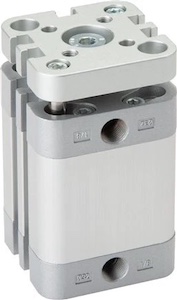ISO 21287 Compact Pneumatic Cylinders

Figure 1: A double-acting ISO 21287 pneumatic cylinder
ISO 21287 pneumatic cylinders adhere to a recognized standard for their design and operation. They use compressed air to generate linear motion. These cylinders are common in industrial automation applications that need high performance but have limited space. This article thoroughly overviews ISO 21287 compact cylinders and highlights their typical applications.
Table of contents
View our online selection of compact pneumatic cylinders!
ISO standards
ISO, the International Organization for Standardization, offers a universally accepted structure to ensure that products, services, and systems consistently meet the highest quality, safety, and performance levels. Experts from various fields collaborate to develop these standards, providing a systematic and organized approach to design, production, and delivery, ultimately mitigating the likelihood of errors, failures, and nonconformities.
Pneumatic cylinder working principle
There are single- and double-acting pneumatic cylinders. Single-acting cylinders operate when compressed air enters the pneumatic port, pushing the piston in a single direction. After the compressed air supply is cut off, a compressed spring returns the piston to its initial position. Meanwhile, double-acting pneumatic cylinders have a pneumatic port on both sides of the cylinder, enabling compressed air to move the piston in both directions, resulting in more precise control over the piston's position. Review our pneumatic cylinder overview to gain further insight into the workings of pneumatic cylinders.
ISO 21287 compact pneumatic cylinders
ISO 21287 is a technical standard that outlines the design and performance criteria for compact pneumatic cylinders that industrial automation systems use. These cylinders have the following advantages:
- Design: Despite their compact size, pneumatic cylinders still provide force up to 1500 N. This makes them suitable for industrial applications with small components that still require a lot of force. For example, gripping, clamping, material handling, and other robotic industrial applications.
- Interchangeability: Compact pneumatic cylinders that fail can be replaced with other ISO 21287 compact pneumatic cylinders, regardless of brand. So users do not have to depend on a specific brand and can choose based on availability and cost.
Characteristics
- Max pressure: 10 bar (145 psi)
- Piston bore sizes: 20 mm, 25 mm, 32 mm, 40 mm, 50 mm, 63 mm, 80 mm, and 100 mm.
- Nominal stroke length: For the nominal stroke length, see values in ISO 4393. The stroke length should not exceed 500 mm.
- Movement direction: Single- and double-acting
- End cover mountings: Use ISO 21287 for end cover mountings on cylinders with 20 mm or 25 mm bore sizes. End cover mountings adhere to the ISO 15552 standard for larger bore sizes.
For specific data on these cylinders' dimensions and other characteristics, refer to the ISO 21287 standard documentation.






